cruise control Citroen C4 CACTUS RHD 2014 1.G Owner's Manual
[x] Cancel search | Manufacturer: CITROEN, Model Year: 2014, Model line: C4 CACTUS RHD, Model: Citroen C4 CACTUS RHD 2014 1.GPages: 331, PDF Size: 8.56 MB
Page 4 of 331
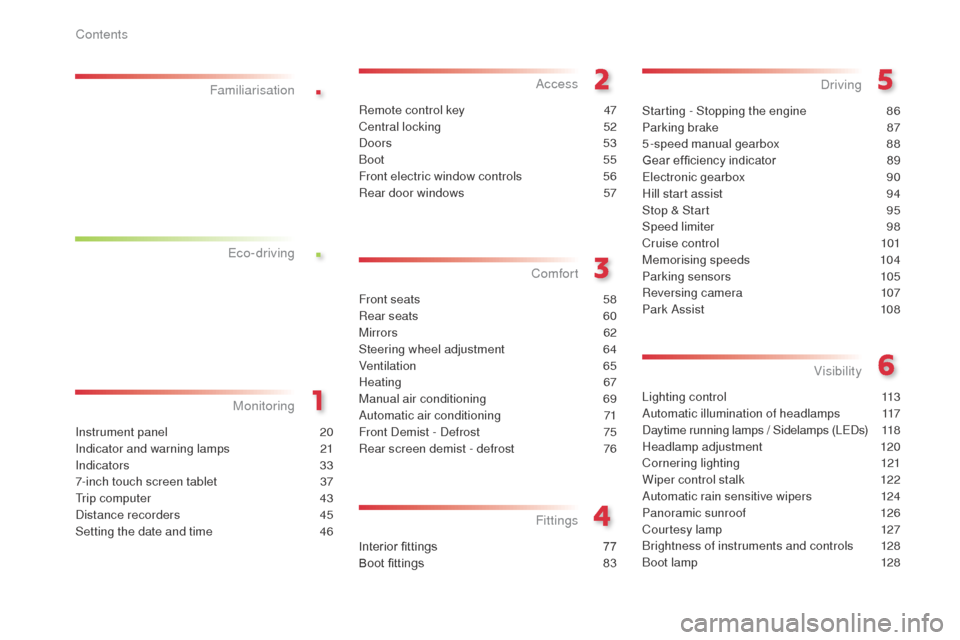
.
.
Lighting control 113
Automatic illumination of headlamps
1
17
Daytime running lamps / Sidelamps (LEDs)
1
18
Headlamp adjustment
1
20
Cornering lighting
1
21
Wiper control stalk
1
22
Automatic rain sensitive wipers
1
24
Panoramic sunroof
1
26
Courtesy lamp
1
27
Brightness of instruments and controls
1
28
Boot lamp
1
28
Visibility
Instrument panel 2 0
Indicator and warning lamps
2
1
Indicators
33
7
-inch touch screen tablet
3
7
Trip computer
4
3
Distance recorders
4
5
Setting the date and time
4
6
Monitoring
Familiarisation
Remote control key 4
7
Central locking
5
2
Doors
53
Boot
55
Front electric window controls
5
6
Rear door windows
5
7
Access
Front seats 58
Rear seats
6
0
Mirrors
62
Steering wheel adjustment
6
4
Ventilation
65
Heating
67
Manual air conditioning
6
9
Automatic air conditioning
7
1
Front Demist - Defrost
7
5
Rear screen demist - defrost
7
6
Comfort
Interior fittings 77
Boot fittings
8
3
Fittings
Starting - Stopping the engine 86
Parking brake
87
5
-speed manual gearbox
8
8
Gear ef ficiency indicator
8
9
Electronic gearbox
9
0
Hill start assist
9
4
Stop & Start
9
5
Speed limiter
9
8
Cruise control
1
01
Memorising speeds
1
04
Parking sensors
1
05
Reversing camera
1
07
Park Assist
1
08
Driving
Eco-driving
Contents
Page 9 of 331
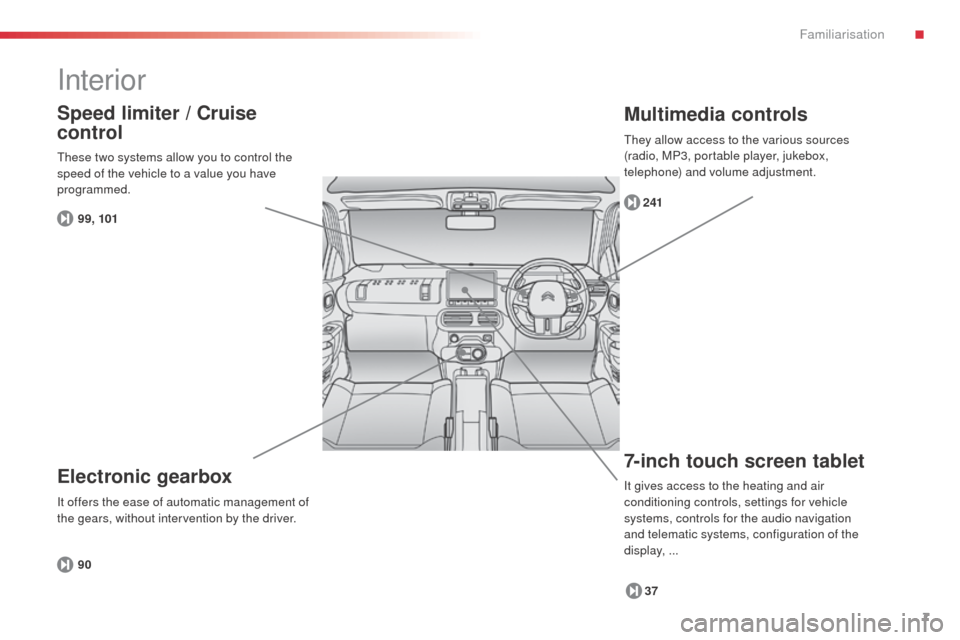
7
Interior
7-inch touch screen tablet
37
241
Multimedia controls
Electronic gearbox
90
Speed limiter / Cruise
control
99, 101
These two systems allow you to control the
speed of the vehicle to a value you have
programmed.
It offers the ease of automatic management of
the gears, without intervention by the driver.
It gives access to the heating and air
conditioning controls, settings for vehicle
systems, controls for the audio navigation
and telematic systems, configuration of the
display,
...
They allow access to the various sources
(radio, MP3, portable player, jukebox,
telephone) and volume adjustment.
.
Familiarisation
Page 10 of 331
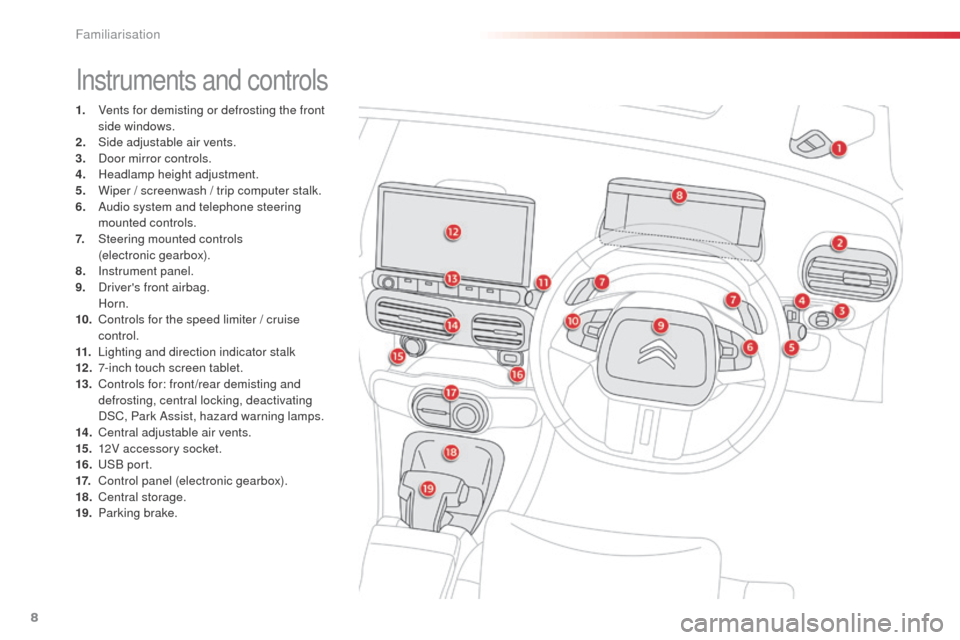
8
Instruments and controls
1. Vents for demisting or defrosting the front side windows.
2.
S
ide adjustable air vents.
3.
D
oor mirror controls.
4.
H
eadlamp height adjustment.
5.
W
iper / screenwash / trip computer stalk.
6.
A
udio system and telephone steering
mounted controls.
7.
S
teering mounted controls
(electronic gearbox).
8.
I
nstrument panel.
9.
D
river's front airbag.
Horn.
10.
C
ontrols for the speed limiter / cruise
control.
11.
L
ighting and direction indicator stalk
12 .
7
-inch touch screen tablet.
13.
C
ontrols for: front /rear demisting and
defrosting, central locking, deactivating
DSC, Park Assist, hazard warning lamps.
14 .
C
entral adjustable air vents.
15.
1
2V accessory socket.
16.
U
SB port.
17.
C
ontrol panel (electronic gearbox).
18.
C
entral storage.
19.
P
arking brake.
Familiarisation
Page 19 of 331

17
Driving safely
1. Select speed limiter mode.
2. Decrease the programmed speed
3.
In
crease the programmed speed.
4.
S
peed limiter On / Pause.
5.
D
isplay the list of memorised speeds.
Speed limiter
"LIMIT"
98 1.
Sel
ect cruise control mode.
2.
A
ctivation of cruise control at the current
speed of your vehicle, then decrease the
programmed speed.
3.
A
ctivation of cruise control at the current
speed of your vehicle, then increase the
programmed speed.
4.
C
ruise control Pause / Resume.
5.
D
isplay the list of memorised speeds.
Cruise control
"CRUISE"
101When selected, the speed limiter or cruise
control mode is displayed in the instrument
panel, accompanied by the value of the
programmed speed.
Display in the instrument panel
Speed limiter
Cruise control
Operation of the speed limiter requires
a programmed speed of at least 20 mph
(30 km/h).
Operation of the cruise control requires
a vehicle speed of at least 25 mph
(40 km/h).
.
Familiarisation
Page 20 of 331
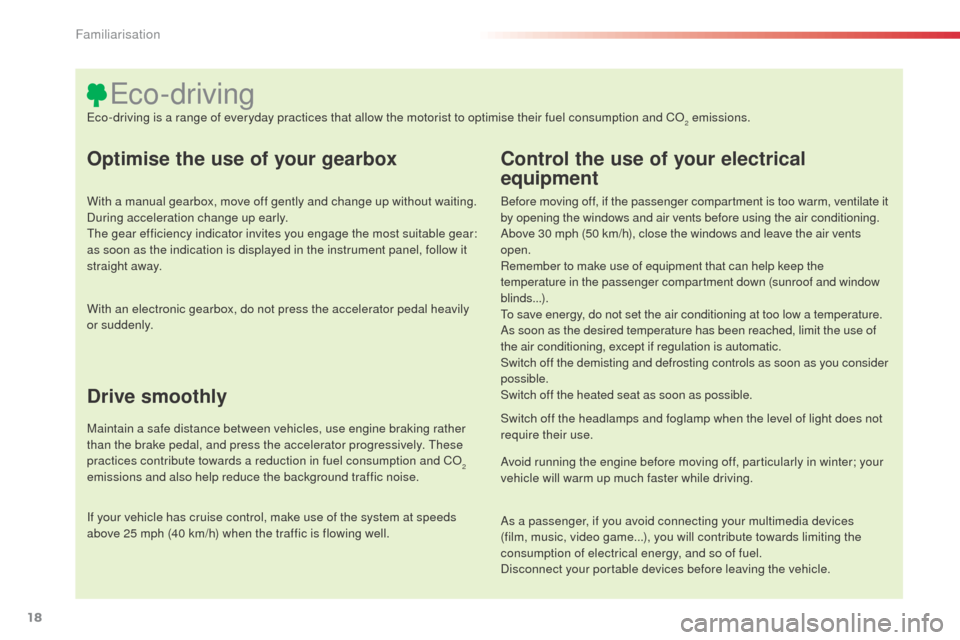
18
Optimise the use of your gearbox
With a manual gearbox, move off gently and change up without waiting.
During acceleration change up early.
The gear efficiency indicator invites you engage the most suitable gear:
as soon as the indication is displayed in the instrument panel, follow it
straight away.
Control the use of your electrical
equipment
Before moving off, if the passenger compartment is too warm, ventilate it
by opening the windows and air vents before using the air conditioning.
Above 30 mph (50 km/h), close the windows and leave the air vents
open.
Remember to make use of equipment that can help keep the
temperature in the passenger compartment down (sunroof and window
blinds...).
To save energy, do not set the air conditioning at too low a temperature.
As soon as the desired temperature has been reached, limit the use of
the air conditioning, except if regulation is automatic.
Switch off the demisting and defrosting controls as soon as you consider
possible.
Switch off the heated seat as soon as possible.
Switch off the headlamps and foglamp when the level of light does not
require their use.
Avoid running the engine before moving off, particularly in winter; your
vehicle will warm up much faster while driving.
As a passenger, if you avoid connecting your multimedia devices
(film, music, video game...), you will contribute towards limiting the
consumption of electrical energy, and so of fuel.
Disconnect your portable devices before leaving the vehicle.
Eco-driving
Eco-driving is a range of everyday practices that allow the motorist to optimise their fuel consumption and CO2 emissions.
With an electronic gearbox, do not press the accelerator pedal heavily
or suddenly.
Drive smoothly
Maintain a safe distance between vehicles, use engine braking rather
than the brake pedal, and press the accelerator progressively. These
practices contribute towards a reduction in fuel consumption and CO
2
emissions and also help reduce the background traffic noise.
If your vehicle has cruise control, make use of the system at speeds
above 25 mph (40 km/h) when the traffic is flowing well.
Familiarisation
Page 41 of 331
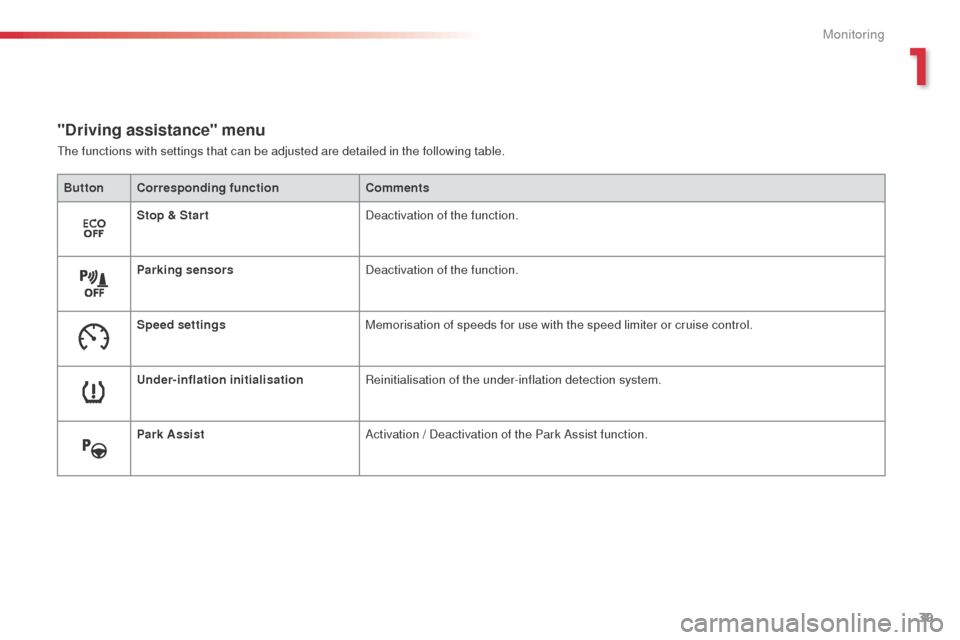
39
"Driving assistance" menu
The functions with settings that can be adjusted are detailed in the following table.Button Corresponding function Comments
Stop & Star t Deactivation of the function.
Parking sensors Deactivation of the function.
Speed settings Memorisation of speeds for use with the speed limiter or cruise control.
Under-inflation initialisation Reinitialisation of the under-inflation detection system.
Park Assist Activation / Deactivation of the Park Assist function.
1
Monitoring
Page 84 of 331

82
To remove the mat on the driver's side:
F m ove the seat as far back as possible,
F
un
clip the fixings,
F
r
emove the mat.
Mats
Removable carpet protection.
Fitting
When fitting the mat for the first time, on the
driver's side use only the fixings provided.
The other mats are simply placed on the
carpet.
RemovalTo avoid any risk of jamming of the
pedals:
-
o
nly use mats which are suited to
the fixings already present in the
vehicle; these fixings must be used,
-
n
ever fit one mat on top of another.
The use of mats not approved by
CITROËN may inter fere with access to
the pedals and hinder the operation of
the cruise control / speed limiter.
The mats approved by CITROËN have
two fixings located below the seat.
Refitting
To refit the mat on the driver's side:
F p osition the mat correctly,
F
r
efit the fixings by pressing,
F
c
heck that the mat is secured correctly.
Fittings
Page 103 of 331

101
Steering mounted controls
The information is grouped together in the
instrument panel.
6.
C
ruise control pause / resume indication.
7.
C
ruise speed setting.
8.
C
ruise control mode selection indication.
Cruise control
System which automatically maintains the speed of the vehicle at the value programmed by the driver, without any action on the accelerator pedal.
The cruise control system cannot, in any
circumstances, replace the need to observe speed
limits, nor can it replace the need for vigilance and
responsibility on the part of the driver.
You are advised to keep your feet near the pedals
at all times.
The controls of this system are grouped
together at the steering wheel.
1.
C
ruise control mode selection wheel.
2.
D
ecrease value or speed setting on the fly
button.
3.
I
ncrease value or speed setting on the fly
button.
4.
C
ruise control pause / resume button.
5.
M
emorised speeds display button.
Display in the instrument panelSwitching off the ignition cancels any
programmed speed value.
5
Driving
Page 104 of 331

102
Switching on
If the cruise control is switched on, you can
then modify the initial speed in one of the
following ways:
-
p
ressing button 5 :
F
t
he six memorised speeds are displayed
in the the touch screen tablet,
F
c
hoose a value: it is displayed in the
instrument panel.
T
he selection screen closes after a
few
moments.
T
he modification is then accepted.
F
T
urn wheel 1 to the "CRUISE" position: the
cruise control mode is selected but is not
switched on (Pause).
F
P
ress button 2 or 3
: your vehicle's current
speed becomes the cruise speed (selected
on the fly).
The cruise control is activated (ON).
Modification of the initial
speed setting
The cruise control is switched on
manually: it requires a minimum vehicle
speed of 25 mph (40 km/h).
The memorised speeds can be
programmed in the "Driving
assistance" menu.
For more information on the list of
memorised speeds, refer to the
"Memorising speeds" section.
Or by:
-
u
sing buttons 2 or 3:
F
b
y successive short presses, to modify
the speed by + or - 1 mph (km/h),
F
b
y a long press, to modify the speed in
steps of + or - 5 mph (km/h),
Driving
Page 105 of 331
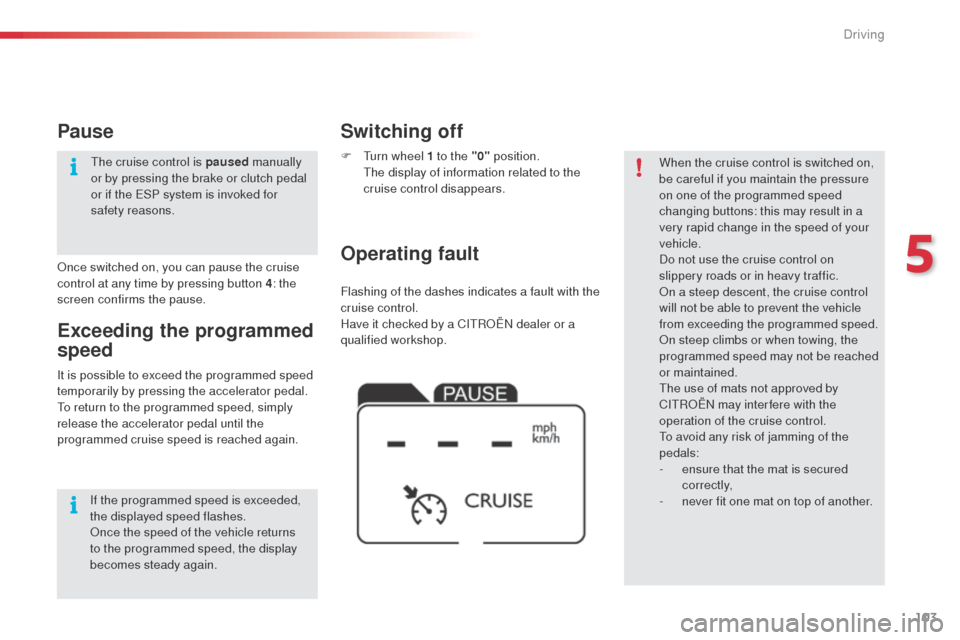
103
Flashing of the dashes indicates a fault with the
cruise control.
Have it checked by a CITROËN dealer or a
qualified workshop.
Operating fault Switching off
F Turn wheel 1 to the "0" position. T
he display of information related to the
cruise control disappears. When the cruise control is switched on,
be careful if you maintain the pressure
on one of the programmed speed
changing buttons: this may result in a
very rapid change in the speed of your
vehicle.
Do not use the cruise control on
slippery roads or in heavy traffic.
On a steep descent, the cruise control
will not be able to prevent the vehicle
from exceeding the programmed speed.
On steep climbs or when towing, the
programmed speed may not be reached
or maintained.
The use of mats not approved by
CITROËN may inter fere with the
operation of the cruise control.
To avoid any risk of jamming of the
pedals:
-
e
nsure that the mat is secured
c o r r e c t l y,
-
n
ever fit one mat on top of another.
It is possible to exceed the programmed speed
temporarily by pressing the accelerator pedal.
To return to the programmed speed, simply
release the accelerator pedal until the
programmed cruise speed is reached again.
Exceeding the programmed
speed
Once switched on, you can pause the cruise
control at any time by pressing button 4: the
screen confirms the pause.
Pause
If the programmed speed is exceeded,
the displayed speed flashes.
Once the speed of the vehicle returns
to the programmed speed, the display
becomes steady again. The cruise control is paused
manually
or by pressing the brake or clutch pedal
or if the ESP system is invoked for
safety reasons.
5
Driving